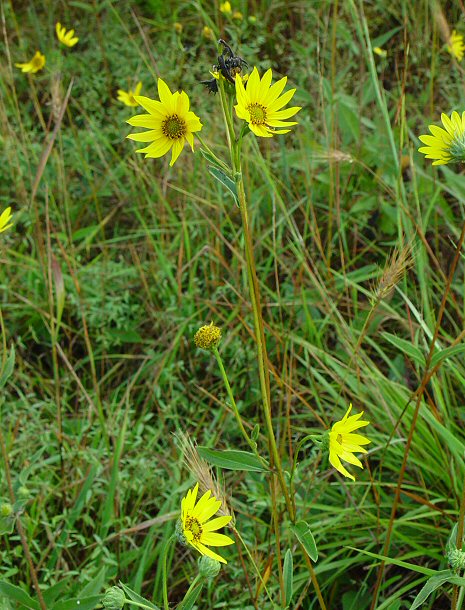Helianthus occidentalis Riddell
Naked-Stemmed Sunflower, Western Sunflower

Native
CC = 5
CW = 5
MOC = 22
© DETenaglia
Helianthus occidentalis RiddellNaked-Stemmed Sunflower, Western Sunflower | |
 |
Native CC = 5 CW = 5 MOC = 22 |
© DETenaglia |
|
Family - Asteraceae/Heliantheae Habit - Perennial forb with slender, long-creeping, branched rhizomes and sometimes also stolons, often colonial. Stems - Ascending to erect, to 1.0 m, single from base, sparsely to densely pubescent with short-ascending or longer and tangled, slender hairs toward the base, glabrous or nearly so above the midpoint (often for most of the length).
Leaves - Basal and opposite, simple, basally disposed with 3-8 nodes, the stem leaves much smaller than the basal leaves, the basal leaves usually long-petiolate, the stem leaves short-petiolate to sessile. Blades of the basal leaves 6-15 cm long, 1-7 cm wide, narrowly to broadly elliptic or ovate, tapered to long-tapered at the base, tapered to a usually sharply pointed tip; those of the stem leaves 1-9 cm long, narrowly oblong-lanceolate to ovate, flat or somewhat cupped or folded longitudinally, angled or tapered at the base, rounded or broadly angled to a bluntly pointed tip, all of the leaves with the margins entire or less commonly finely toothed, flat, the surfaces strongly roughened-pubescent with moderate to dense, short, stiff, broad-based hairs, often also with sparse, sessile, yellow glands, with 3 main veins, the lateral pair branching from the midnerve usually well above the base of the blade, arching upward.
Inflorescence - Terminal solitary heads or open clusters, occasionally with additional heads on branches from upper leaf axils.
Heads - Radiate. Involucre 7-12 mm long, 9-15 mm in diameter, usually slightly shorter than the tips of the disc corollas, the bracts in 3 or 4 noticeably unequal, overlapping series, lanceolate, tapered to a sharply pointed, usually appressed-ascending tip (at least at flowering), the margins with a fringe of short, spreading hairs, the outer surface glabrous or sparsely pubescent with short, stout, ascending, sometimes broad-based hairs, especially toward the base, often also with sparse, minute, sessile, yellow glands. Receptacle convex, the chaffy bracts 5-7 mm long, narrowly oblong to narrowly oblong-oblanceolate, angled or short-tapered to a sharply pointed, green or straw-colored tip with hairy margins, occasionally with a pair of additional short, broad lobes toward the tip, the outer surface also usually glabrous.
Flowers - Ray florets 8-15, sterile, the corolla 1.5-3.0 cm long, glabrous or the outer surface with inconspicuous, short, slender hairs and scattered, minute, sessile, yellow glands. Disc florets perfect, the corollas 4.5-5.5 mm long, yellow, glabrous. Pappus of 2 scales 1.5-3.0 mm long, these lanceolate to narrowly triangular, tapered to a sharply pointed, often minutely awnlike tip, also usually with 1-4 additional shorter, ovate scales 0.3-1.0 mm long.
Fruits - Achenes 3-4 mm long, wedge-shaped to obovate, only slightly flattened but usually bluntly 4-angled in cross-section, moderately to densely pubescent with short, ascending hairs when young, only those at or toward the tip persistent at maturity, with fine, darker and lighter brown mottling. Flowering - July - September. Habitat - Upland prairies, glades, savannas, dry upland forest openings, pastures, fields, fencerows, roadsides. Origin - Native to the U.S. Lookalikes - Broadly, numerous other species of Asteraceae, particularly those in the Astereae and Heliantheae tribes. Other info. - This relatively small species of sunflower can be found in a cluster of counties centered in the lower half of Missouri. The ssp. occidentalis which occurs in Missouri is more common to our north, particularly in Illinois, Michigan, and Wisconsin, and also occurs in widely scattered and sparse populations eastward. The plant is recognized by having nearly leafless upper stems, with most leaves either basal or toward the bottom of the stem. The flowering heads are typical of the sunflowers, with sterile rays (lacking visible styles) and yellow disks. The other subspecies, ssp. plantagineus (Torr. & A. Gray) Heiser, D.M. Sm., Clev. & W.C. Martin, occurs to our south and differs by its softer, appressed leaf hairs. Photographs taken off Hwy 21, Reynolds County, MO., 8-20-03 (DETenaglia); also at Victoria Glade, Jefferson County, MO, 8-5-2016, and at Valley View Glade Natural Area, Jefferson County, MO, 8-5-2016 and 8-14-2020 (SRTurner). |